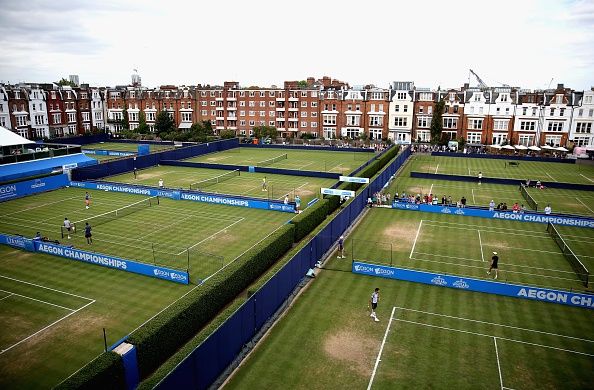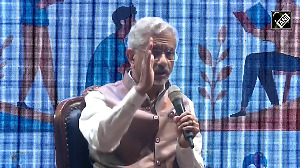And no, it doesn't begin with a W...
Rahul Jacob rhapsodises about the world's most picturesque tennis venue.

The decent-sized crowd watching Nick Kyrgios, tennis' most complicated and conflicted talent since John McEnroe, suggested a first-round match at the Aegon Championships at London's Queen's Club had started a day early.
It was a practice session where tennis' bad boy, infamous for throwing matches when he appears to lose interest in playing, kept up a steady stream of self-criticism.
"Oh my god. You just can't help yourself. You want to hit harder and harder and harder," shouted Kyrgios as a forehand sailed long.
Not long after, he called it quits on the practice session in 30 degrees Celsius heat that felt like 40 degrees Celsius.
"I'm losing stimulation very slowly. That's when stupid things happen," he explained with endearing candour to his friend and practice partner Thanasi Kokkinakis.
The following day Kyrgios slipped and fell hard, reinjuring his left hip.
As he lay on the grass, writhing in pain, a spectator behind me grumbled, "He's such a drama queen. I've never seen a match of his where there wasn't an incident."
It may have been unkind, but it was an insight into how polarising tennis' most charismatic next generation star is and how knowledgeable and opinionated the crowd at the Aegon Championships tends to be.

One of the particular charms of the Queen's Club courts is their intimacy makes one feel as if one is watching a club championship that just happens to have more than its fair share of top ten tennis players.
On one Tuesday the crowds watched in quick succession Milos Raonic, Stanislas Wawrinka and Andy Murray.
The three top seeds lost, but that's in the nature of early season grass court tennis, which is inherently unpredictable.
Another is that the tournament has often been a good predictor of form for Wimbledon, but for the absence of one Roger Federer, who preferred to play at the tournament in Halle, Germany the same week.
Last year's winner and runner-up at Wimbledon, Murray and Raonic, had just played in the final at the Aegon Championships a couple of weeks earlier.
Boris Becker became the youngest winner at Queen's Club in 1985 and then won Wimbledon as an unseeded 17 year old weeks later.
India's Ramanathan Krishnan won at Queen's in 1959 beating Neale Fraser, but never got further than the semi-finals at Wimbledon in 1960 and 1961, losing to Fraser and Rod Laver respectively.
And then there are the joys of watching grass court tennis, which brings out more of the cat and mouse game of charging the net than any other surface.
The ATP now has a longer grass court season with an extra week between the French Open and Wimbledon, allowing tournaments like the Mercedes Cup in Stuttgart to have their moment in the sun.
The courts at Queen's though seem to be the fastest of them all, but when I put this question to Graham Klimpton, the head groundskeeper at Queen's Club, he tells me that is an optical illusion.
The International Tennis Federation measures court speeds at different grass court tournaments, Klimpton says, and "there are very small margins between the grass court venues. Last year, we were slightly faster."

Beauty, though, lies in the eyes of the spectator.
There is nowhere else on earth that I would rather watch tennis.
I arrived intending to write about a tournament I grew to love while attending it regularly between 2005 and 2008 when tickets were easy to come by.
I recall getting tickets at a week's notice when my late father, who played tennis through much of his adult life, stopped in London on his way back from the United States.
We couldn't believe our good fortune when the final proved an epic encounter between Rafael Nadal and Novak Djokovic in 2008. (Nadal famously beat Federer to win Wimbledon in a marathon weeks later.)
As so often happens, much has changed -- and yet a great deal remains as before.
Last year's tickets sold out within 24 hours, but this year proved easier because the centre court has increased in size by 2,000 seats, from the original 6,500.
(Getting tickets to Wimbledon, by contrast, literally involves winning a lottery; one must enter a ballot by December 31 the year before to have a chance.)
The bigger stadium still ensures there is hardly a bad seat.
The tournament is a much swankier if commercial place than it used to be with expanded dining facilities and bars on the grounds.

After watching Jo-Wilfried Tsonga practise, I wandered into a tent of commerce tucked away at the back of the club grounds where sponsors promoted their wares.
There was a large poster of Judy Murray, Andy and Jamie's mother, improbably endorsing a Peugeot SUV, and samples being handed out of a protein-rich meat substitute called Quorn and of a new Dove deodorant.
Chris Kermode, the Association of Tennis Professionals executive chairman, who headed the Aegon Championships when the changes unveiled this year were first planned, says there was a desire to raise the profile of the tournament and give it the global status it deserved.
"Whenever you make changes like this, everyone assumes it's about the revenue. We lacked the visual impact that this is a big event," he says.
The place still retains much of its old world charm. The red-brick exterior of the clubhouse is one flank of the main court; it's hard to miss that every seat on that side reserved for members of Queen's Club is occupied.
As Andy Murray continued his run of mostly unexplainable losses this year, going down flailing to an Australian named Jordan Thompson, every bit of standing room was taken.
Members even huddled between air conditioner exhausts on one balcony to watch the match.
Murray's press conference afterward was punctuated by the nearby sound of a game of real tennis, an ancient game that is a hybrid between squash and tennis played at the club.
The good-looking young stewards in their blue trousers, blue loafers and white straw hats were very capable.
To a man and woman, they could rattle off the names of little-known doubles players on court even if they looked like they had been abducted from the sets of Brideshead Revisited, the 1980s television serial of the Evelyn Waugh novel.
The Aegon Championships at Queen's seems more a fictional account of a perfect summer's day in England, this year especially.
With news of random terrorist attacks, a mythically inept prime minister and a horrific fire in a mismanaged public housing estate that laid bare the inequalities of a capital that has become a Monte Carlo-styled tax haven by the Thames, this has been a summer horribilis in London.
Well-executed solutions are urgently necessary, but so too are the occasional diversion.
Despite unheralded players mowing down the top seeds that Tuesday, against the odds, the Aegon at Queen's delivered again.
Fittingly, the players voted it their favourite venue for a tournament of this size last year.














 © 2025
© 2025